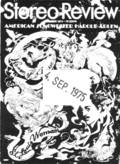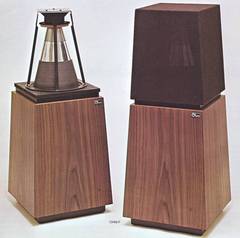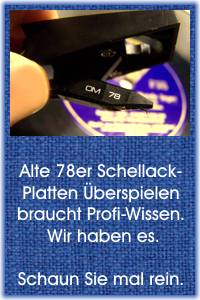Dieser OHM F Test stammt bereits aus Sept. 1973
Diese uralte Fotokopie ist so ausgeblichen, daß man kaum erkennen kann, wo das mal abgedruckt war. Der Test (Text) selber ist zum Glück einigermaßen leserlichen und die Buchstaben sind lesbar erhalten. (vermutlich doch Stereo Review Sept. 1973 - obwohl der Hasselbachsche Tagesstempel des Erhalts auf 1975 hinweist).
-
Ohm F Speaker System (Test from 1973)
We have all heard the story (probably apocryphal) about the aerodynamic experts who analyzed the wing structure of the bumble bee (Anmerkung: ein "bumble bee" ist eine Hummel!) and concluded that it simply could not fly. Fortunately, as the story goes, the bumble bee is ignorant of aerodynamic theory and continues to fly without apparent difficulty.
.
Like the bumble bee, the new Ohm F loudspeaker would seem to be an impossibility according to conventional speaker theory. A single driver, with an unusually large cone whose shape suggests a dunce cap, is mounted facing downward into a sealed enclosure filled with sound-absorbing material.
A 3-inch voice coil, edge-wound with anodized aluminum wire, drives the cone structure, which is formed of 1-mil titanium foil at the top, 3-mil aluminum foil in the middle, and paper at the bottom. The three materials are bonded rigidly together. The cone is 12 inches in diameter at its widest point and is about 12 1/2 inches high.
Although one might conceive of such a cone assembly serving as a woofer, one would not expect it to perform with equal effectiveness over the full audiofrequency range - and beyond.
However, it does just that. The explanation, according to Ohm Acoustics, is that the cone has not been designed to function as a "piston" (as virtually all other cones are), but should be viewed as a terminated acoustic-transmission line (see the accompanying box for a detailed discussion). It is based on a design patented by the late Lincoln Walsh, who will be remembered by old-time audiophiles for his Brook amplifiers of the late Forties.
The Ohm F has a nominal voice-coil impedance of 3 to 4ohms. Its efficiency is somewhat lower than that of the better acoustic-suspension speakers, and an amplifier rated at 50 watts or more per channel is recommended. (Up to 300 watts can be handled for brief intervals without damage to the speaker, which is protected by a fast-acting fuse.)
The system has a rated frequency response of 32 to 20,000 Hz ±3.5 dB, subject to some variation according to room characteristics and measurement techniques. It is omnidirectional in the horizontal plane, and the response is claimed to be down only 3dB at 20,000 Hz at an angle 40 degrees off its horizontal axis. The overall size of the Ohm F is 44 inches high and 17 3/4 inches square at the base, tapering to 13 inches square at the top. The base is finished in oiled walnut, and the system weighs about 75 pounds.
Laboratory Measurements
Our standard live-room integrated frequency response measurement of the Ohm F produced one of the flattest extended curves we have ever seen from a loudspeaker. Especially outstanding was the absence of any low-frequency or mid-range irregularities; the response was ±2 dB from 40 to 7,500 Hz, and it rolled off smoothly at lower frequencies. At the higher frequencies, the inevitable irregularities due to room reflections and microphone effects appeared, with a moderate peak reaching a maximum at 15,000 Hz, and a return to the mid-range frequency-response level at 20,000 Hz.
The bass harmonic distortion at a 10-watt drive level was 4% at 40Hz, 10%at 29Hz, and 16% at 25 Hz. At frequencies above 50Hz it was 3% or less. At a 90dB sound-pressure level (SPL) it was quite similar, reaching 14% harmonic distortion at 30Hz. The electrical impedance was just under 4 ohms in the mid-range, increasing to about 5 ohms at frequencies above 2,000 Hz and reaching a maximum of 9 ohms at the system resonance of 38Hz.
The efficiency, as noted, was low, with 18 watts needed to produce a 90dB SPL in the mid-range at a distance of 1 meter.
One of the fascinating aspects of testing the Ohm F was verifying the claimed phase coherence of its cylindrical radiation pattern. Ohm literature shows a clearly identifiable, if not perfect, square-wave response from the acoustical output of the system as an indication of the system's phase accuracy over a wide range of frequencies.
We verified this in our tests, and also tried the same procedure on several other fine speakers we had on hand. Only the Qhm F was able to produce a reasonable facsimile of a square wave. Another indicator of the transient behavior of the system is its tone-burst response.
When we used the test procedures we have employed in the past, the tone bursts from the speaker appeared reasonably good, but not exceptional. However, when we concentrated on the first one or two cycles of the burst (see the 2,000Hz tone-burst photo), it was plain that the tone-burst started in the correct phase and reached nearly its frill amplitude in the first half cycle.
This may not sound unusual, but, again, a check of other speakers in the same manner showed that every one failed to follow the burst accurately during the first couple of cycles.
The tests we have made (including others too lengthy to describe here) all tended to confirm the claims made for the Ohm F: that it has a uniform energy output across the full audio-frequency range, that it radiates a cylindrical, coherent (in-phase) wavefront, and that it has transient-response capabilities surpassing those of the best conventional (piston) speakers.
Comment
A speaker with the unusual tested performance of the Ohm F could hardly fail to sound exceptionally good, so we were not surprised to find that it did.
Its sound was different from that of the other fine speakers we had on hand, in a way (spatial properties?) that was difficult to define. Of course, all the overworked cliches and adjectives (sweet, easy, open, unstrained, etc.) apply in full measure to the sound of the Ohm F.
In our simulated live-vs.-recorded test it rated A to A+ depending on the specific musical selection involved. Considering that its 360-degree directional properties differed radically from those of the wide-dispersion (but not omnidirectional) test speaker employed as our "live" source, this was a notable achievement.
Despite the relatively low efficiency of the Ohm F, it could be driven to reasonable levels by a good 30-watt-per-channel amplifier. Of course, with one of the larger power amplifiers, able to deliver 100 watts or more, the sound began to warrant the use of such words as "awesome."
The low bass, too, was extraordinarily clean and powerful. We had problems with objects in the room rattling at moderate listening levels, and this has occurred only rarely in the past.
It should be apparent from the foregoing that we include the Ohm F among those few speakers we have tested that achieves state-of-the-art performance.
In addition, the Ohm F can do some things that no other speaker in our experience is capable of. Whether the ability, for example, to reproduce a recognizable square wave, and what that implies, has audible consequences is as yet not known (at least, to us), but it is certainly no minor accomplishment.
As to whether or not the Ohm F is therefore the "best" speaker available - we will leave that to the ears of audiophiles; we are prepared to say, however, without reservations, that it is easily one of the best.
.



